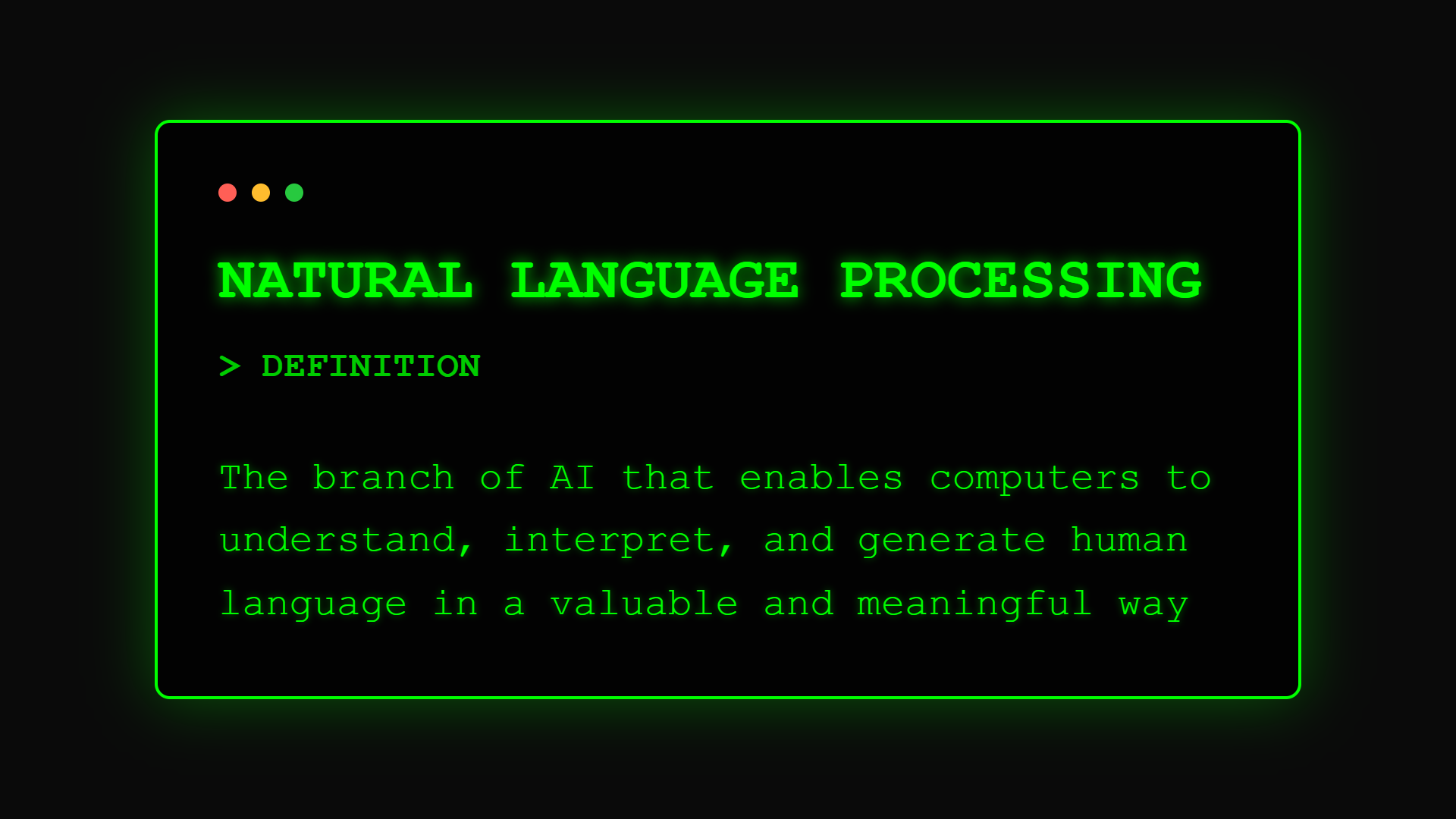AI Terms
What is Natural Language Processing? When AI Speaks Your Language

Every day, your business generates millions of words: emails, reviews, support tickets, social posts. What if you could instantly understand all of it? Natural Language Processing makes this possible, enabling computers to read, understand, and respond to human language as naturally as your best employee.
Origins and Technical Definition
Natural Language Processing emerged in the 1950s from the intersection of linguistics and computer science. Alan Turing's 1950 paper "Computing Machinery and Intelligence" proposed that a machine's ability to converse naturally would be the ultimate test of intelligence.
The Association for Computational Linguistics defines NLP as "a field of computer science and artificial intelligence concerned with the interactions between computers and human language, particularly how to program computers to process and analyze large amounts of natural language data."
Early NLP relied on hand-coded rules and linguistic theories. The field transformed in the 2010s with deep learning, shifting from rigid rules to pattern recognition, culminating in today's large language models that understand context and nuance.
Practical Business Meaning
For business leaders, NLP means technology that can read, understand, and communicate in human language, turning unstructured text and speech into actionable business intelligence.
Think of NLP as giving your systems the ability to be multilingual in the broadest sense: fluent not just in different languages, but in understanding intent, emotion, and context behind words. It's like having thousands of employees who can instantly read every customer email, analyze every review, and respond appropriately.
In practical terms, this enables chatbots that actually understand questions, analytics that extract insights from documents, and systems that can summarize meetings or generate reports.
Fundamental Components
NLP consists of these essential elements:
• Text Processing: Breaking down language into analyzable units (words, sentences, paragraphs) while handling variations like slang, typos, and abbreviations
• Semantic Understanding: Grasping meaning beyond literal words, recognizing that "battery died" could mean phone, car, or metaphorical energy depending on context
• Intent Recognition: Identifying what someone wants to achieve, distinguishing "I want to cancel" (action request) from "How do I cancel?" (information request)
• Sentiment Analysis: Detecting emotional tone and opinion, understanding if "interesting choice" is genuine praise or subtle criticism
• Language Generation: Creating human-like responses, from simple templates to sophisticated conversational replies
How NLP Functions
The NLP process follows these steps:
Input Processing: Raw text or speech is cleaned and standardized by removing extra spaces, expanding contractions, converting speech to text
Linguistic Analysis: Text is parsed to understand structure, identifying parts of speech, sentence boundaries, and grammatical relationships that reveal meaning
Semantic Interpretation: The system extracts meaning by analyzing word relationships, context clues, and learned patterns to understand intent and sentiment
This enables machines to move from seeing "The product arrived late and damaged" as just words to understanding it as a negative customer experience requiring urgent attention.
Three Core Applications
NLP generally falls into three main categories:
Type 1: Text Analytics Best for: Customer feedback analysis, document classification, trend detection Key feature: Extracts insights from large volumes of text Example: Analyzing 10,000 reviews to identify product issues
Type 2: Conversational AI Best for: Customer service, virtual assistants, chatbots Key feature: Enables natural dialogue between humans and machines Example: Support bots that handle 80% of routine inquiries
Type 3: Language Generation Best for: Content creation, report writing, personalization Key feature: Creates human-like text from data or prompts Example: Generating personalized email responses at scale
NLP in Practice
Here's how businesses actually use NLP:
Customer Service Example: Bank of America's Erica handles 19.5 million client requests monthly, understanding complex questions and providing personalized financial guidance with 90% satisfaction rates.
Healthcare Example: Mayo Clinic uses NLP to analyze clinical notes, extracting relevant information 40x faster than manual review while identifying 25% more relevant patient conditions.
Legal Example: JPMorgan's COIN system reviews commercial loan agreements in seconds using NLP, completing 360,000 hours of annual lawyer work with higher accuracy.
Expand Your Knowledge
Ready to implement NLP in your business?
- Start with Artificial Intelligence fundamentals
- Explore Machine Learning that powers NLP
- Learn about Sentiment Analysis for customer insights
- Implement with our NLP Implementation Guide
FAQ Section
Frequently Asked Questions about Natural Language Processing
Part of the [AI Terms Collection]. Last updated: 2025-01-10